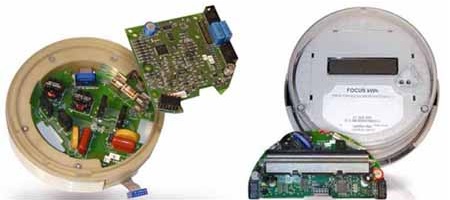On August 31, 2011, an Idaho Power Contractor asked permission to enter my yard to install a smart meter. I refused permission for that purpose. After several phone conversations and letters back and forth, Chris Bell, a customer service representative for Idaho Power showed up at my door with a Deputy Sheriff to force the installation of the smart meter. I filed a formal complaint with the Idaho Public Utilities Commission that resulted in the opening of IPC-E-12-04.
The meter that Idaho Power installed is the Landis+Gyr residential with the Aclara Two-Way Automated Communications (TWACS) software and circuit board for communications using power line carrier communications (PLCC) protocol. The TWACS components were shipped directly to Landis+Gyr to be installed in the meters before delivery to Idaho Power per Idaho Power direct testimony of Mark C. Heintzelman to the IPUC, Case IPC-E-08-16.

Photo Source: http://www.electricnet.com/doc/electric-metering-transponders-aclara-twacs-0003
In general, the term ‘Smart’ as a noun refers to integrated computer hardware and/or software. The Smart Meter for utilities is a computerized device that includes data collection, data storage, data communications for transmission of meter data to the utility company. The data collection tables conform to ANSI Standard C12.19 Utility Industry End Device Data tables.
The Smart Meter is the end-use component of the Smart Grid which includes a hardware and software overlay on top of the electric grid. At the industrial interface points where mechanical equipment is installed, Supervisory Control and Data Acquisition (SCADA) systems are used to control the intelligent (synonym for smart) mechanical devices and processes.

The objective of Smart Grid infrastructure is to have total ‘Situational Awareness’ over the entire electric grid right down to the level of recording a “toast event” at your house at 7:10 am on Tuesday. Situational Awareness is for the purpose of managing and controlling the use of electricity (demand management). Toward that end, electrical devices of all types are being designed to include smart grid interfaces to allow control of them from remote locations.
Manufacturers are still in the early stages of development for these interfaces, but the direction is clear. The following are excerpts from a study performed by the Pacific Northwest National Laboratory operated by Battelle for the U.S. Department of Energy:
Pacific Northwest Gridwise Testbed Demonstration Project
Part II. Grid Friendly Appliances Project
Report published October 2007
Project for the U.S. DOE under Contract DE-AC05-76RL01830
https://www.smartgrid.gov/sites/default/files….
The Grid Friendly Appliance Project tested the hypothesis that the GFA controller could directly contribute to frequency protection on the electric power grid. It performed a function similar to what is now practiced at some substations where underfrequency relays autonomously react to shed the load of entire feeders when low-frequency thresholds are crossed–
From early 2006 through March 2007, Pacific Northwest National Laboratory (PNNL) managed the Grid Friendly Appliance Project, a field demonstration of autonomous, grid-responsive controller called the Grid Friendly appliance (GFA) controller. This device is a small electronic controller board that autonomously detects underfrequency events and requests that load be shed by the appliance that it serves.
The study used 150 new residential clothes dryers that were manufactured for the project by Whirlpool Corporation and 50 retrofitted residential water heaters. The appliances were modified to shed portions of their electrical loads when they received signals from their GFA controllers…
Whirlpool Project
Here is another project for smart appliance development using federal grant money. Notice that the Key Targeted Benefit was reduced peak consumption – otherwise known as peak shaving. Also notice, ‘wireless communications and advanced control software’.

The significance of wireless communications on appliances is that remote control of the device can be triggered not just by low frequency as described in the Pacific Northwest Project, but can be triggered by the smart meter with software and the TWACS communications capability. The Aclara TWACS communications hardware and software with the Landis+Gyr meter can be configured to collect water and gas meter usage information when combined with the Badger water meter with Orion software. This demonstrates the fact that the smart meter is a gateway device to all of the “smart devices” in a person’s home. It should be noted that the wireless communications with smart devices at a residence does not mean that it operates instead of PLCC protocol for communications with the utility. Rather, it is in addition to PLCC in the same way that your computer can wirelessly communicate with your modem or mouse in addition to communicating through the internet over a phone line or cable connection.











One Comment
Pingback: Suitable for Infants, A Narrative of Huge Pieces, Do you see what it is yet. – Not The Grub Street Journal